Mechanical Wall-Mantle Clock Kits Info Tabs
Mechanical Clock Kit Styles Available
Mechanical Clock Kit Styles Available include wall clocks, mantle (shelf) clocks, and floor clocks. Floor models includes the granddaughter, grandmother, and grandfather series. Mechanical Clock Kit Styles are in the list below.
Mantle clocks
Mantle clock kits are always spring driven and wound with a clock key. Moreover, it can come in a variety of chime types. Triple chime, Westminster only, bell strike, bim bam or gong strike.
If the clock has three places to wind with the key it is a quarterly chime unit. This means it is either Triple chime or Westminster only. In other words every 15 minutes it will progressively play part of the song. At the top of the hour it will play the complete song then strike out the hours.
Wall clocks
Wall clock kits may be spring driven or weight driven. There are more spring driven wall clocks in the world than weight driven. The weights are not light and it is a lot for a wall to hold.
So fastening it well is very important. The movement can have a pendulum or no pendulum but of course the pendulum is most popular. When a mechanical clock does not have a pendulum it has a balance wheel instead. This is a floating and rocking wheel on the top of the movement and operates more like a watch balance.
Mechanical Clock Kit Styles - Granddaughter or Grandmother clocks
Typically, granddaughters are spring driven with no weights.
The grandmothers are usually chain driven. The chiming units have three weights. Any other strike style has two weights. It is a shorter clock overall than a grandfather clock.
Grandfather clock kits
Typically cable driven with three weights and triple chimes.
This means the weights will hang on cables instead of chains, and plays choice of three songs. However it is not always triple chime because some are Westminster only. This is the largest and tallest of the floor clocks.
Chime types
All of the above mechanical clock kit styles, in the past, have been made with every chime type. In other words there are all these various ways to make the clock play a song or make a noise.
There is the quarterly sounds that play a tune ever quarter hour, the most common of the songs is Westminster. Or there is the triple chime that includes Westminster, St. Michaels, or Whittington.
As for the other noise makers, we call them strike clocks because they only strike out the hours and usually bong once on the half hour. These include Gong strike (coil gong on the back or below the movement), Bell strike, or Bim Bam (sounds like its name, on two or three strike rods).
Mechanical clock-kit movement options
The following are the various options for Mechanical clock-kit movements to utilize in building a clock.
We offer complete kits at Clockworks, however we can't include them all as it would be overwhelming. It may be possible to alter any aspect in the clock kits that are available. Please call to let us help with kit modifications or for general assistance.
Mechanical clock-kit movement options - Floor Clocks
Chime type
Either Westminster only or triple chime. Both of these Mechanical Clock Kit options play a melody every 15 minutes and require a three weight movement.
Also there is the bell strike option that will play on the top of the hour whatever hour it is, and once on the half hour.
Pendulum
Options are the length, the bob diameter, and if would like a wood stick style The Pendulum or a fancy lyre style The Pendulum. The wood stick style is more antique look and the lyre is the contemporary style.
Hammer location
Either on the back for standard depth cases, or for the shallow depth we can do a side hammer unit.
Dial
Either a phase of the moon style, or just the hump top that says Tempus Fugit. Or we can zip off any moon Dial or TF dial to provide a very nice square metal dial with no hump on the top at all.
Another option is to use heavy paper stock on a thin board, use spray glue to make it stay.
Mechanical clock-kit movement options - Wall Clocks
Chime type
Either Westminster only, Triple chime, Bim Bam, gong or bell. Lots of chime options there, but whatever wanted to listen to out of these we can do.
Pendulum
Either the wood stick style or sometimes if its short enough, we can put a brass rod pendulum in.
The Mechanical Clock Kit options brass rod pendulum is different than the metal lyre pendulum as its just a brass rod going straight down with out all the decor.
Hammer Location
Includes the back, or on the side, or even the bottom on the wall clock kits.
Dial
Square dial made of heavy paper stock that uses a spray glue in order to attach it to a thin board, or a metal dial.
In Arabic or Roman numerals. The dial on a wall clock would mount to the wood trim that goes around the dial, not interlocking with the movement.
One style you can't get these days are the round dials that do lock into the movement, to have the appearance of the dial just floating in the air with the mounting hidden such as the Vienna regulator style.
Mechanical clock-kit movement options - Mantle or Shelf Clocks
Mechanical clock-kit movement options - Chime type
All of them really. an have Westminster, triple chime, gong, bell, or Bim Bam strike for Mechanical clock movement kit options.
Mechanical clock-kit movement options - Pendulum
Options include metal rod to a decor for the kitchen style clocks are available, or a wood stick pendulum if the clock is tall enough. For the shorter mantle units it will be just a round bob that is usually adjustable for time keeping.
Mechanical clock-kit movement options - Dial
The hardest on the mantle units. To get a the dial with bezel with glass in convex or flat is ideal, however not always possible.
If the situation calls for this type of clock dial, may want to chase a different clock design to make, it is not often it works out well unfortunately. The shelf clocks are easier as it has a door that closes with glass in the front, rather than the round brass bezel with dial and glass all in one combination.
This concludes the Mechanical Clock-Kit movement options. Please call to discuss the clock kits with us 800 381 7458.
Clock kit before building the clock case
It is important to order the clock kit before building the clock case. It's possible the kit will not fit if the case is built before getting the mechanical clock kit.
Although it may seem counterintuitive, it is more common than you might think. To put a lot of effort into building a luxury case only to realize that the necessary components do not fit inside. It is advisable to purchase the clock kit first to avoid this frustration and potential financial loss, . This will allow you to ensure that all the components fit properly before investing time and resources into the case.
Why order a clock kit before building
To find or adapt a clock kit to the case is very difficult. The ideal dial or other parts may not exist in the size that the case requires.
Moreover, measurements need to be correct for the clock kit to fit into the case.
Always order the Mechanical Clock Kit before building the case. Having the clock kit set up on a stand while working on the case is ideal.
Naturally, it will be easy to measure the various parts of the clock kit such as the pendulum swing and dial. Having the luxury of the components being in the air makes it much easier to measure and is a wise decision.
Not all clocks are made
Many sizes of antique clocks dials are not made anymore. Grandfather clocks back in the day had large Clock dials with ships on them.
They most certainly are gorgeous but try to find another one like it. These are no longer available. This is the case with many others as well. This is yet another reason to buy the clock kit before building the case.
The winding arbor holes will need to be done, if a dial can be found. This way it will have a hole to put the key or crank into. Chain driven clocks are the only style that does not need winding holes in the dial.
Alternate kit component availability
Clockworks offers a large variety of clock movements. However, when it comes to some components resources can get slim. This is why it is important to buy the clock kit before building the case.
Clock dials are the hardest because there are so many shapes, sizes, and options available. Examples include round dials, square, hump top with no moon, and moon dials.
Summary
To sum up this topic on clock kits. It is wise to get the Mechanical Clock Kit before building the clock case. The best thing to do is set up the movement kit in the workshop. This way you can visualize the size prior to installation.
So, do not build a beautiful case before buying components for it. Purchasing all of the components first will give you the opportunity to measure them and ensure they will fit in the case. This will help you avoid the disappointment of designing a case that cannot accommodate your components.
Mounting the Gong
Gong-Strike Wall Clock Kit Instructions begins with the gong installation. The coil gong mounts in the back of the clock case first before the movement. The strike hammer is on the back of the movement.
It adjusts with the wire that the hammer head is on. The hammer on the movement gets its final adjustment by bending the wire the hammer is on.
The destination where the hammer should strike is in the center of the round gong, on the flat portion. This is where it should make contact. When the hammer is at rest, it should be about 1/8 inch away from the gong wire.
There needs to be a space between the hammer and the gong wire so the hammer will make a crisp gong sound without double hitting, thudding, or missing the gong completely.
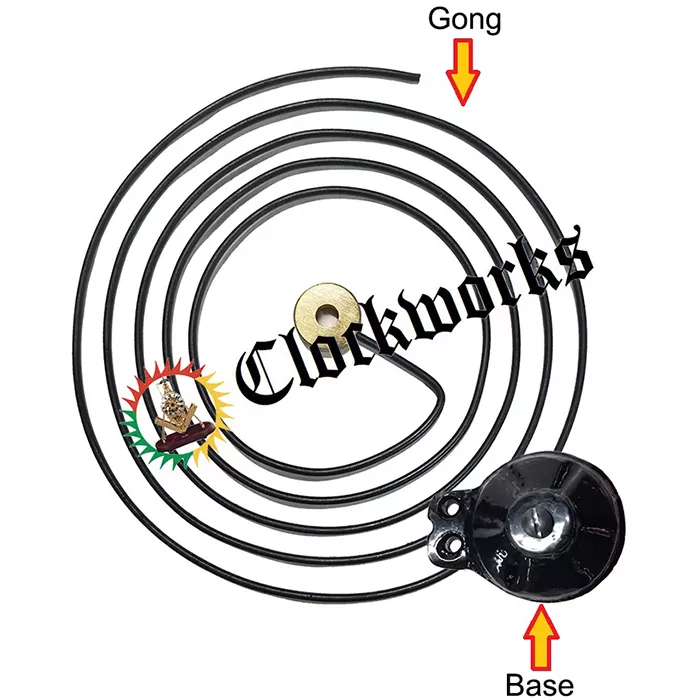
The gong comes with a small metal mounting base. After the base installation, the gong wire is next. The base has a mounting screw that is already in the base's center. Take the screw off the base, put the gong wire on it, then screw it back together.
Before tightening it up too much, position the gong wire to its approximate position and then tighten it. Approximate position because as previously mentioned, the hammer wire on the movement is what will be the final adjustment.

Gong-Strike Wall Clock Kit Instructions - Mounting the Dial
The dial on this kit is a simple white round dial with gold trim and Arabic numerals. We drill the dial for the winding arbor configuration of the movement. This is done so the clock can be wound up with the key.
Attach the dial to a thin board by drilling holes and using some brass finishing nails, or screws, to adhere it to the board. Alternately, epoxy will also work to attach it to the board. Position the dial so the hand shaft itself and the winding posts align with the dial holes.
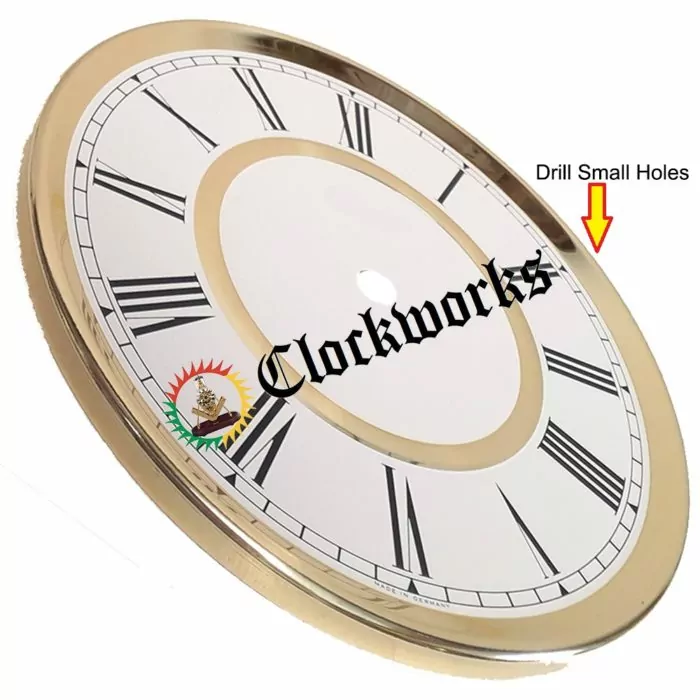
Gong-Strike Wall Clock Kit Instructions - Installing the Hands
After mounting the dial, it is time to put the hands on the clock. First, install the hour hand. It is a friction fit so twist and push down toward the dial at the same time. The more the hour hand pushes down, the tighter the fit will be because the post is tapers.
Fairly snug but not touching the dial or the minute hand. The hour hand, the dial, and the minute hand should all be parallel with each other. They cannot hit each other during any part of their rotation.
Hands for modern German units have a center mount in the minute hand that rotates. If the clock does not strike exactly on the hour or the quarters like it should, follow the following steps. To correct this issue, take the minute hand off of the clock and turn it over.
With a pair of needle nose pliers, rotate the center mounting bushing a little bit. Hold the minute hand in one hand, the needle nose pliers in the other while grabbing and spinning this center hand bushing.
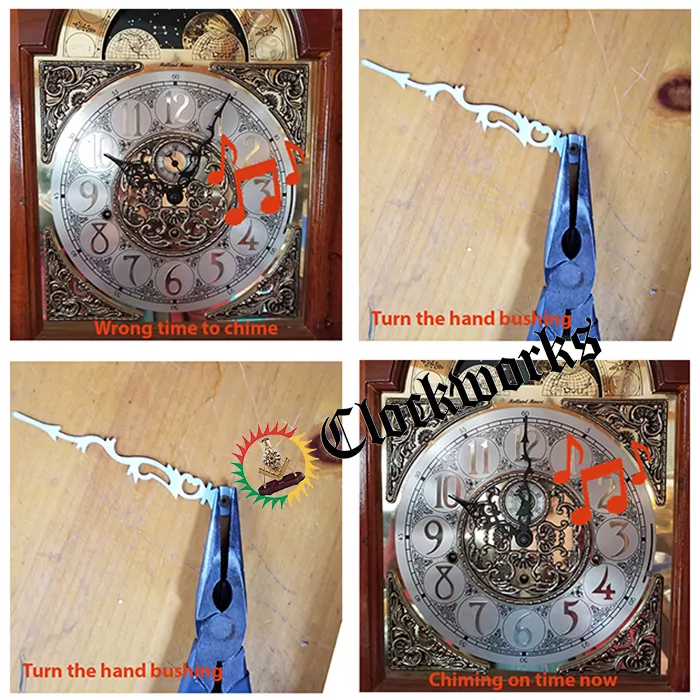
Gong-Strike Wall Clock Kit Instructions - Hanging the Pendulum
The three components are the suspension spring at the very top, the leader it hangs on, and then the pendulum length all the way down to the very bottom of the pendulum rating nut threads.
The movement will arrive with the the suspension spring already in place. However, the leader that hangs on it may not be. Put on as follows: Take the set screw out of the suspension post to release the suspension spring and then lower it some. When lowering the spring, hook on the leader.
At the same time, the leader should engage with the crutch that swings back and forth on the back of the movement. Goal is to have the leader in the center of the crutch that swings it, hooking up the top to the suspension.
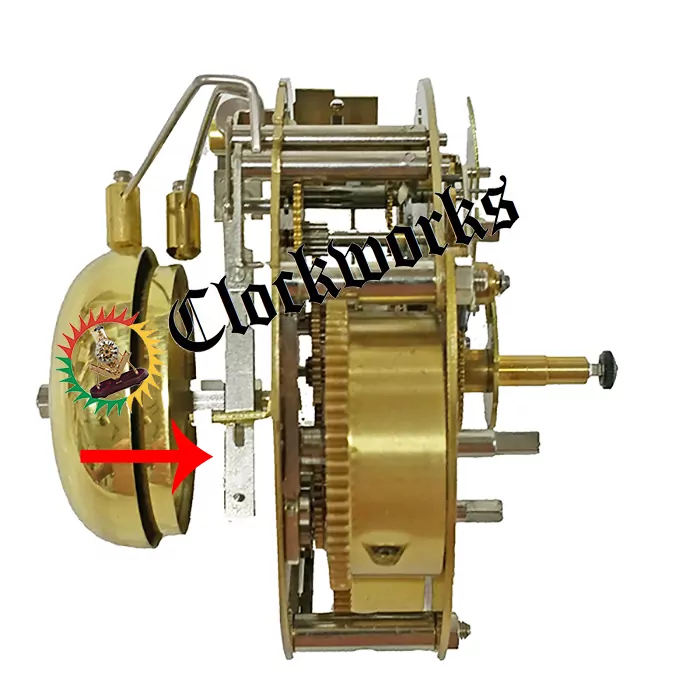
Once you attach the leader to the suspension, bring the two part assembly back up to where it should be. Reinstall the thumb screw that holds the suspension spring, and now also the leader. Hang the pendulum onto the bottom of the leader and put it in beat. It will not run if it is not put into beat, this is easy to do.
Gong-Strike Wall Clock Kit Instructions - Why put a clock in beat
Every pendulum clock needs to be put into beat to operate. If the clock is not put into beat it will run for 5 minutes to 12 hours and then stop every time.
A common issue with mechanical clocks is that it stops working after moving it. This is usually from someone moving the clock without taking the pendulum off and this puts the clock out of beat.
Out of beat is a term in the clock repair world that basically means the clock is going tock-tick, tock-tick instead of tick - tock - tick - tock. The easy fix is by tilting the clock and putting a shim under one side.
This can temporarily correct the problem and the clock runs fine. This method, however, is not as good as correcting the beat and having the clock run when it is truly straight and level.
Adjust the beat by pushing the top of the pendulum left or right as it hangs in its clock case. Hold a lower portion of the pendulum with the left hand as pushing the top of the pendulum left or right with the right hand. Feel the freedom in the pendulum to move left or right.
With some resistance at the sides at the end of the left or right travel. The is changing the beat of the clock when going beyond this resistance and therefore changing the place of the freedom area. Do not worry about breaking the clock there is nothing to break when going left or right.
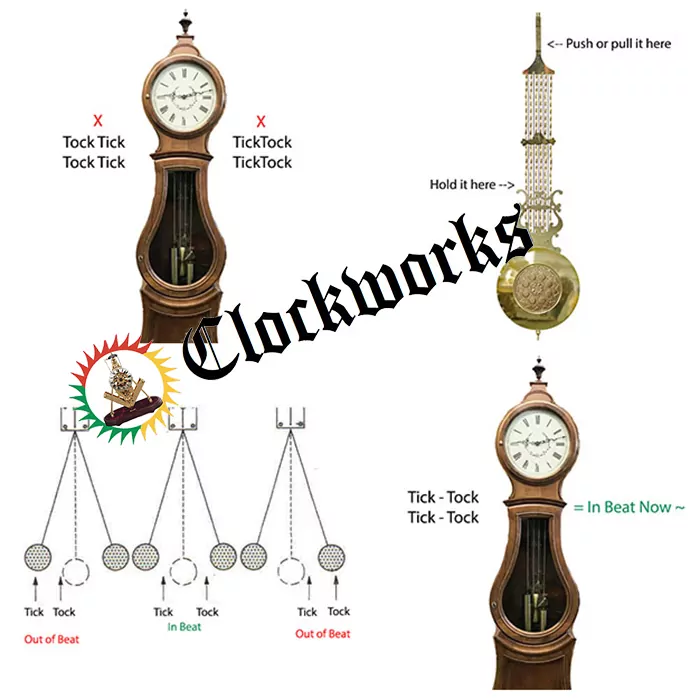
Timing
The pendulum is responsible for all the timekeeping of the movement. There is a rating nut on the bottom of the pendulum that turns to get the time perfect. Timing a clock takes some time and patience to get perfect and adjust it a few times to get it right.
When turning this nut, it is either raising or lowering the round bob at the bottom of the pendulum. This positioning is what speeds or slows time. Turning the nut to the right to raise the bob, time will go faster. Turn it the opposite way to slow it down.

This concludes the Gong-Strike Wall Clock Kit Instructions.

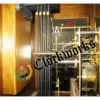
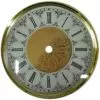
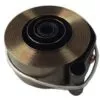
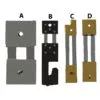
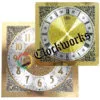











You guys have so many different clocks, Im looking to buy a movement today, great website.